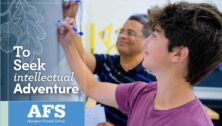Abington Friends School Ramps up Lesson Plan to Define Speed for Young Students

Speed is a curious measurement.
At first blush, it appears simple: Things can go fast or slow.
But when it comes down to it, what is speed itself?
When two balls race down an incline, why does one reach the bottom first?
And more important, how is this concept explained five-year-olds?
The Specifics of Speed
This year, the Abington Friends School (AFS) early childhood program (Catbird class) has been busy diving into the specifics of speed.
The starting point for the Jenkintown students was the important question: How fast do moving objects travel?
An interesting way to explore that question came from AFS Upper-School math teacher Mary Anne Wassel
She reasoned that the difference in two moving objects was best estimated when observed. And she concluded that the easiest way to illustrate the concept is to release two objects side by side on a ramp and see which reached the bottom first.
So that’s exactly what Wassel did.
An Amped-up Ramp
She enlisted the aid of four members of the AFS Roobotics Club to build a ramp for the class
But not just any ramp.
She envisioned a multi-level ramp with multiple different angles — but one that would be safe for play by three- and four-year-olds.
Roobotics’ team members got to thinking.
“The ramp was deceptively difficult,” said Kiera Larrieu, ramp project lead.
“It ended up taking longer than expected because of the size screws that we needed. The plywood wasn’t thin by any means, but for screwing in the hinges, we needed half-inch screws, which we had, but they were very low quality and kept breaking.
“And since the product was going to Lower Schoolers, we sanded all of our wood to not cause injuries.
“Which I unfortunately don’t normally do. So, it was actually a learning experience.”
She continued: “I think my favorite part was the planning stage.
“We used math that we had learned in class and had never gotten a chance to apply to the real world, which just made us feel really smart and cool.”
Wassel was impressed with the resulting structure and complimented its creators. “It was great practice for Roobotics,” she said. “The students really took the lead on design.”
Time to Rock and Roll
When it came time to test the ramp, the Catbirds were eager to rock — and roll — plenty of items down to test its speed capabilities.
They started with different kinds of cars, followed by wheels and blocks, both round and square.
All the while, the young students predicted — and debated — which objects they believed would race fastest. In those exchanges, they were encouraged to theorize about their expectations, thoughtfully considering likely speed influences (materials, sizes, and shapes) and those less likely to have an effect (colors).
But best of all, the conjecture got real when they were able to test their forecasts.
“It was great practice for Roobotics,” said Wassel. “The students really took the lead on design.”
Ramp builder Larrieu said, “I think my favorite part was the planning stage. We used math that we had learned in class and had never gotten a chance to apply to the real world, which just made us feel really smart and cool.”
Collaboration at Its Best
The demonstration was truly a collaborative effort. The Roobotics Team members who were instrumental in the project were:
- Kiera Larrieu
- Casey Rush
- Sophia Wang
- Niels Rush
Connect With Your Community
Subscribe for stories that matter!
"*" indicates required fields






























